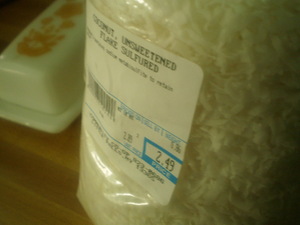Coconut milk is a pantry staple for any home cook with a passion for ethnic or natural cooking. Aside from being a key ingredient in Thai, Southeastern Asian, African and Brazilian cuisines, it can be substituted for dairy milks in baking recipes, and is also a great ingredient in smoothies and exotic cocktail recipes.
No longer relegated to randomly stocked “gourmet cooking’, dusty, end-of-ailse shelves as it was little more than a decade ago, it is now easily found in larger grocery chains. Canned coconut milk is available from recognizable, quality brand names, and there are even several organic options. Great news for the adventuresome cook, right? Well, yes…and no.
Unfortunately, coconut milk is not inexpensive. For anyone cutting back on grocery expenses, that $3.00 can of liquid for one single dish is probably going to be one of the first sacrifices. Also, if you’re only going to be using a portion of the can’s contents, the remaining coconut milk spoils fairly quickly, even in an air tight container in the refrigerator.
Fortunately, there’s a very economical and easy way to make your own coconut milk, in any amount you like. Unsulphured, unsweetened, shredded coconut is available as a bulk item in natural food sections, and natural food grocery stores. This is not the same item found in the regular baking section-traditional shredded coconut has added sugar and preservatives, and is not appropriate for making coconut milk.
The bulk coconut is very inexpensive-only about $2.89 for a full pound, which will make many “cans” of milk. The shredded coconut keeps very well in a mason jar, Tupperware container, or even a properly sealed Zip lock bag, on a pantry shelf.
The process for making coconut milk is easy, requires no great time, and can be done quickly while noodles are boiling, or vegetables are sautéing. Below is everything you’ll need, and all the instructions and notes you’ll need to make your own, delicious coconut milk.
Ingredients and equipment
Unsulphured, unsweetened shredded coconut
Distilled or filtered water
Blender, Magic Bullet, or food processor
Hand held, medium sized strainer or sieve
Medium bowl
Spatula or wooden spoon
Optional: Half & Half or plain Silk Soy Creamer
Method
In a blender, Magic Bullet, or food processor, puree the shredded coconut with filtered or distilled water. The proportions are a matter of taste, but a general ratio for medium thin cooking milk is ¾ cup shredded coconut to 1 cup water. This will make a bit less than I cup of milk.
Blending time should be rather long, at least a full minute altogether, so the coconut is shredded into fine enough bits, to release the maximum amount of oils, sugar, and flavor. Blend in intervals, checking on consistency and flavor, as well as pushing coconut clumps, and oil globules back into the liquid for incorporation-it has a tendency to hang out around the sides of the blending device.
You may find that a thick paste has formed around the sides of the blender-this is desired, and a good sign you have some really good, fresh coconut. It is coconut oil, and all or some of it can be incorporated into the milk, depending on the desired fat content.
Keep in mind much of the flavor and consistency is in this oil. If you do prefer to remove some, it makes a fantastic skin lotion, as well as an overnight hair conditioner. People purchase expensive, unfiltered coconut oil for this very purpose.
After you have blended the coconut and water, strain the mixture through a hand held sieve or strainer, into a bowl. Much of the milk will be trapped in the pulp, so use the back of a spoon to push as much of the liquid out as possible. Your fist (super clean hands, of course) likewise makes a great liquid pusher .
Taste the milk, and if you’d like a stronger flavor or thickness, blend the milk with an appropriate amount of more fresh shredded coconut, and repeat the process of scraping down the sides as you’re blending, and straining.
Notes and tips
If I’m making coconut milk for a curry or other sturdy dish, I usually incorporate some of the coconut pulp that is leftover in the sieve, for added flavor, and texture.
I have also found that adding a bit of Half & Half, or plain Silk brand soy creamer to the final mixture creates a more traditional, familiar coconut milk-and is especially good if using it for smoothies or anything requiring an overall, finer texture.
Another note–If you have the time, you can soak the coconut in hot, not-quite-boiling distilled or filtered water, for about as long as you would steep a strong cup of tea, prior to the entire process. The hot water releases the natural oils, and nicely softens the dry coconut, which lends a smoother texture, if you wish to incorporate any of the actual coconut itself into the milk or dish you are preparing. After soaking, use the soaking water and hot coconut to create the milk with the same method indicated above.






